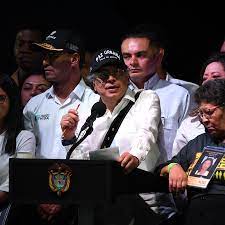
Colombian Army Reports Abduction of 57 Soldiers in Restive Southwest

 :
| Updated On: 24-Jun-2025 @ 1:18 pm
:
| Updated On: 24-Jun-2025 @ 1:18 pmSHARE
The Colombian army reported that more than 50 of its soldiers were captured by civilians in a restive, mountainous region in the country’s southwest. This area, known as the Micay Canyon, is a critical zone for cocaine production and has long been associated with armed conflict and insecurity. On Saturday, a platoon of soldiers was first seized during a military operation in El Tambo, a municipality within the canyon. A day later, another group of soldiers was surrounded and detained by at least 200 civilians while heading toward the town of El Plateado in the same region.
The army confirmed on Sunday that, as a result of these two incidents, 57 soldiers in total remain held. This includes four noncommissioned officers and 53 professional soldiers. The military described the incidents as a form of kidnapping. General Federico Alberto Mejia, who leads military operations in Colombia’s southwest, stated in a video message that the soldiers were abducted by rebels who had infiltrated and manipulated the local civilian population to carry out the detentions.
The Colombian armed forces believe that these civilians are acting under the influence or direct control of the Central General Staff (EMC), the primary dissident faction of the Revolutionary Armed Forces of Colombia (FARC). This group rejected the 2016 peace agreement between the FARC and the Colombian government and continues to engage in armed activities, particularly in regions where the state has limited control.
President Gustavo Petro, Colombia’s first leftist president, addressed the situation on social media, calling the soldiers’ release an “imperative.” Petro, who campaigned on promises to achieve “total peace” through negotiation and reconciliation with rebel groups, has struggled to maintain control over various armed territories and contain violence across both urban and rural areas.
For several months, the Petro administration has attempted to reassert state control over Micay Canyon, recognizing its strategic importance both for security and counter-narcotics efforts. However, the government’s efforts have been challenged by the resurgence of violence, as various rebel groups—including FARC dissidents and criminal gangs—seek to occupy the power vacuum left after the original FARC demobilized following the 2016 peace accord.
The return of such groups has stoked fears among many Colombians of a relapse into the extreme violence of the 1980s and 1990s, a period marked by rampant cartel activity, guerrilla warfare, and political assassinations. The situation has become even more fragile since peace talks between the government and the FARC-EMC collapsed in 2023, after a series of deadly attacks on Indigenous communities attributed to the rebel faction.
The capture of the soldiers highlights the continued influence of armed groups in Colombia’s conflict zones and exposes the limits of state authority in remote areas. It also underscores the challenges facing President Petro’s peace agenda, as violence and insecurity persist despite diplomatic overtures and military operations. The government now faces pressure to negotiate the soldiers’ safe release while confronting the growing reach of dissident factions and maintaining public trust in the peace process.